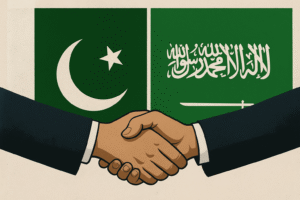South Asia’s Arms Race: A Consequence of Great Power Contestation

South Asia’s Arms Race: A Battleground for U.S.-China Rivalry. The growing military buildup in the region reflects the strategic competition between global superpowers.
An epochal global struggle to maintain the U.S.-led order amidst the multipolar world was mentioned in the 2022 U.S. National Security Strategy. The United States’ primary concern is maintaining a “U.S.-led, international order.” A key concern for the U.S. is that Russia or China could eventually dominate the global order or work to replace it altogether. This competition in the international order is the point of contestation between the United States and other major powers. The U.S.-led order, which emphasizes a system of alliances and partnerships to maintain global security, has inadvertently fueled the arms race in South Asia by exacerbating regional security dilemmas.
To secure its influence, the U.S. forms strategic partnerships that support its vision, reassuring allies through security commitments. whereas, other Great powers view these alliances as a direct threat. To uphold this delicate balance in US favor, the Washington. has overtly increased its military presence and support for allies across the globe, intending to counter perceived threats from rival powers. However, by establishing strategic partnerships globally, the U.S. has heightened insecurities among various states. In response, these states build up military capabilities, triggering an arms race and weapons proliferation.
The arms race in South Asia is not merely a regional security competition but a direct consequence of great power contestation, where the U.S.-led international order, through its strategic partnerships particularly with India, has exacerbated regional insecurities, compelling states like Pakistan and China to bolster their military capabilities. While India’s military expansion, backed by U.S. technological and strategic support, disrupts the fragile regional balance, Pakistan’s response is driven by the need for strategic parity rather than aggressive expansionism. This escalating cycle underscores the urgent need for a more balanced and inclusive approach to arms control that addresses the security concerns of all regional actors rather than reinforcing global power dynamics at the cost of South Asian stability.
For instance, the U.S. provision of weapons to Taiwan, Ukraine, or India induces a heightened sense of insecurity among neighboring actors. This dynamic follows the security dilemma, where one state’s pursuit of security triggers insecurity in others, leading them to bolster their defense capabilities. The U.S.’s unwavering support for India, illustrated by the Indo-US Nuclear deal, NSG waiver, and other strategic partnerships, has intensified other regional states’ security concerns. Reflecting this response, the Arms Control Association stated that China’s nuclear warhead count increased from 200 in 2011 to nearly 400 within a decade. The reason is the U.S.’s increased activities in the region to reinforce its US-led order.
The United States’ strategic partnership with India, particularly under initiatives like the so-called Indo-Pacific Strategy, QUAD has emboldened New Delhi to enhance its conventional and nuclear military capabilities. Through strategic defense partnerships, intelligence sharing, and advanced technology transfers, the Quad strengthens India’s position in the Indo-Pacific region. Agreements like COMCASA and BECA, enhance India’s real-time intelligence and surveillance capabilities, improving its conventional warfare potential. Additionally, deeper defense cooperation indirectly aids India’s nuclear deterrence by strengthening its second-strike capabilities through improved maritime domain awareness and anti-submarine warfare. Furthermore, access to advanced Western military technology, including drones and fighter aircraft, augments India’s conventional force projection.
This partnership, marked by significant arms deals and technology transfers, is perceived by Pakistan as a threat to its security, prompting Islamabad to seek parity. Additionally, U.S. arms sales and technological support to India, to counter China, have disrupted the fragile balance of power in South Asia, the more powerful India becomes, the more belligerent its stance tends to be towards Pakistan. Thus, compelling Pakistan to strengthen its defensive measures. This cycle of actions and reactions perpetuates the arms buildup in the region. However, such military buildup risks escalating regional tensions, particularly with China and Pakistan, potentially undermining strategic stability in South Asia.
Whereas, Pakistan’s threat perception is primarily driven by Indian actions. This makes it necessary for Pakistan to adjust its deterrence posture to address the widening conventional asymmetry. Moreover, Pakistan is a staunch supporter of disarmament which is evident from Pakistan’s efforts toward disarmament in the region. Indian actions in the region, create the pulse of an Arms race by severely disturbing the strategic balance in South Asia. It becomes a compulsion for Pakistan to respond by ensuring restraint in the region. Pakistan has consistently advocated for regional and global disarmament, emphasizing South Asia’s need for strategic stability.
Pakistan has supported various arms control initiatives, including proposals for a South Asian Nuclear-Weapon-Free Zone (1974) and a Bilateral Non-aggression Pact with India. Additionally, in 1988 Pakistan became the first state that proposed the establishment of a Strategic Restraint Regime based on the premise of three mutually reinforcing elements of conflict resolution, nuclear and missile restrain, and conventional balance. That shows that Pakistan does not favor the arms race in South Asia. Despite security concerns, Pakistan has shown commitment to international disarmament frameworks by engaging in UN-led initiatives and supporting the objectives of the Chemical Weapons Convention (CWC) and Biological Weapons Convention (BWC).
Additionally, Pakistan maintains a policy of credible minimum deterrence and has demonstrated responsible nuclear stewardship by adhering to international nuclear safety and non-proliferation norms, including its voluntary adherence to IAEA safeguards. However, regional dynamics, particularly India’s arms buildup and advancements in missile defense and AI-driven warfare, continue to challenge Pakistan’s arms control and disarmament efforts in the region. Despite these challenges, Pakistan remains engaged in diplomatic forums such as the Conference on Disarmament (CD) and actively contributes to discussions on non-proliferation, emphasizing the need for a fair and non-discriminatory approach to arms control in South Asia.
But the ongoing major power tug of the war has exacerbated a relentless arms race across South Asia. Ironically, while Pakistan is often criticized for not adhering to the norms of an international order, a closer analysis reveals that Pakistan is largely contending with the consequences of great power rivalries. Pakistan is a developing state and has no intrinsic incentive to engage in an arms race. However, the ongoing great power contestation to sustain a US-led international order has left Pakistan with no choice. Both great powers, the United States and Russia continue their strategic partnerships with India, providing lethal technologies, waivers, and other critical support, which intensifies Pakistan’s need to be at parity with India. The United States, instead of lecturing states on weapons proliferation and arms control must put a cap on its growing temptation to uphold the US-led international order to halt the ongoing Arms buildup in South Asia.
In conclusion, the struggle between a U.S.-led order has significant consequences for arms control and security dynamics, especially in regions like South Asia. While the U.S. seeks to uphold its influence through strategic alliances and partnerships with India, these moves trigger security concerns among regional powers. Great Powers must recognize that global Arms Control and Disarmament objectives cannot be pursued in isolation, disregarding genuine security concerns and vital national security interests of other states.



